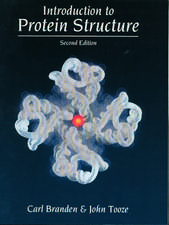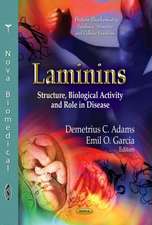Membrane Proteins Production for Structural Analysis
Editat de Isabelle Mus-Veteauen Limba Engleză Hardback – 20 iun 2014
| Toate formatele și edițiile | Preț | Express |
|---|---|---|
| Paperback (1) | 951.77 lei 6-8 săpt. | |
| Springer – 2 sep 2016 | 951.77 lei 6-8 săpt. | |
| Hardback (1) | 958.07 lei 6-8 săpt. | |
| Springer – 20 iun 2014 | 958.07 lei 6-8 săpt. |
Preț: 958.07 lei
Preț vechi: 1168.38 lei
-18% Nou
Puncte Express: 1437
Preț estimativ în valută:
183.35€ • 190.71$ • 151.37£
183.35€ • 190.71$ • 151.37£
Carte tipărită la comandă
Livrare economică 14-28 aprilie
Preluare comenzi: 021 569.72.76
Specificații
ISBN-13: 9781493906611
ISBN-10: 1493906615
Pagini: 452
Ilustrații: XXIII, 425 p. 108 illus., 72 illus. in color.
Dimensiuni: 155 x 235 x 30 mm
Greutate: 0.81 kg
Ediția:2014
Editura: Springer
Colecția Springer
Locul publicării:New York, NY, United States
ISBN-10: 1493906615
Pagini: 452
Ilustrații: XXIII, 425 p. 108 illus., 72 illus. in color.
Dimensiuni: 155 x 235 x 30 mm
Greutate: 0.81 kg
Ediția:2014
Editura: Springer
Colecția Springer
Locul publicării:New York, NY, United States
Public țintă
ResearchCuprins
.- 1 Membrane Proteins Production for Structural Analysis
.- Isabelle Mus-Veteau, Pascal Demange, Francesca Zito
.- 2 Membrane Protein Quality Control in Cell-Free Expression Systems: Tools, Strategies and Case Studies
.- Davide Proverbio, Erik Henrich, Erika Orbán, Volker Dötsch and Frank Bernhard
.- 3 Bacterial Expression and Stabilization of GPCRs
.- Jean Louis Banères
.- 4 Membrane Protein Production in Escherichia Coli: Overview and Protocols
.- Georges Hattab, Annabelle Y. T. Suisse, Oana Ilioaia, Marina Casiraghi, Manuela Dezi, Xavier Warnet, Dror Warschawski, Karine Moncoq, Manuela Zoonens and Bruno Miroux
.- 5 Lactococcus Lactis, Recent Developments in Functional Expression of Membrane Proteins
.- Sana Bakari, François André, Daphné Seigneurin-Berny, Marcel Delaforge, Norbert Rolland and Annie Frelet-Barrand
.- 6 Overexpression of Membrane Proteins in Saccharomyces Cerevisiae for Structural and Functional Studies: a Focus on the Rabbit Ca2+-ATPase Serca1a and on the Yeast Lipid “Flippase” Complex Drs2p/Cdc50p
.- Cédric Montigny, Hassina Azouaoui, Aurore Jacquot, Marc le Maire, Christine Jaxel, Philippe Champeil and Guillaume Lenoir
.- 7 Amphipols: a General Introduction and Some Protocols
.- Manuela Zoonens, Francesca Zito, Karen L. Martinez and Jean-Luc Popot
.- 8 New Amphiphiles to Handle Membrane Proteins: “Ménage à Trois” between Chemistry, Physical-Chemistry and Biochemistry
.- Grégory Durand, Maher Abla, Christine Ebel and Cécile Breyton
.- 9 Building Model Membranes with Lipids and Proteins: Dangers and Challenges
.- James Sturgis
.- 10 Analytical Ultracentrifugation and Size Exclusion Chromatography Coupled to Light Scattering for the Characterization of Membrane Proteins in Solution
.- Aline Le Roy, Cécile Breyton and Christine Ebel
.- 11 Lipidic Cubic Phase Technologies for Structural Studies of Membrane Proteins
.- Andrii Ishchenko, Enrique Abola and Vadim Cherezov
.- 12 Micelles, Bicelles, Amphipols, Nanodiscs, Liposomes or Intact Cells: the Hitchhiker's Guide to the Membrane Protein Study by NMR
.- Laurent J. Catoire, Xavier L. Warnet And Dror E. Warschawski
.- 13 Foundations of Biomolecular Simulations: A Critical Introduction to Homology Modeling, Molecular Dynamics Simulations and Free Energy Calculations of Membrane Proteins
.- Jérôme Hénin, Marc Baaden, Antoine Taly
.- 14 Structural Studies of TSPO, a Mitochondrial Membrane Protein
.- Jean-Jacques Lacapere, Soria Iatmanen-Harbi, Lucile Senicourt, Olivier Lequin, Piotr Tekely, Rudra N. Purusottam, Petra Hellwig, Sebastien Kriege, Stephanie Ravaud, Céline Juillan-Binard, Eva Pebay Peyroula, Vassilios Papadopoulos
.- Isabelle Mus-Veteau, Pascal Demange, Francesca Zito
.- 2 Membrane Protein Quality Control in Cell-Free Expression Systems: Tools, Strategies and Case Studies
.- Davide Proverbio, Erik Henrich, Erika Orbán, Volker Dötsch and Frank Bernhard
.- 3 Bacterial Expression and Stabilization of GPCRs
.- Jean Louis Banères
.- 4 Membrane Protein Production in Escherichia Coli: Overview and Protocols
.- Georges Hattab, Annabelle Y. T. Suisse, Oana Ilioaia, Marina Casiraghi, Manuela Dezi, Xavier Warnet, Dror Warschawski, Karine Moncoq, Manuela Zoonens and Bruno Miroux
.- 5 Lactococcus Lactis, Recent Developments in Functional Expression of Membrane Proteins
.- Sana Bakari, François André, Daphné Seigneurin-Berny, Marcel Delaforge, Norbert Rolland and Annie Frelet-Barrand
.- 6 Overexpression of Membrane Proteins in Saccharomyces Cerevisiae for Structural and Functional Studies: a Focus on the Rabbit Ca2+-ATPase Serca1a and on the Yeast Lipid “Flippase” Complex Drs2p/Cdc50p
.- Cédric Montigny, Hassina Azouaoui, Aurore Jacquot, Marc le Maire, Christine Jaxel, Philippe Champeil and Guillaume Lenoir
.- 7 Amphipols: a General Introduction and Some Protocols
.- Manuela Zoonens, Francesca Zito, Karen L. Martinez and Jean-Luc Popot
.- 8 New Amphiphiles to Handle Membrane Proteins: “Ménage à Trois” between Chemistry, Physical-Chemistry and Biochemistry
.- Grégory Durand, Maher Abla, Christine Ebel and Cécile Breyton
.- 9 Building Model Membranes with Lipids and Proteins: Dangers and Challenges
.- James Sturgis
.- 10 Analytical Ultracentrifugation and Size Exclusion Chromatography Coupled to Light Scattering for the Characterization of Membrane Proteins in Solution
.- Aline Le Roy, Cécile Breyton and Christine Ebel
.- 11 Lipidic Cubic Phase Technologies for Structural Studies of Membrane Proteins
.- Andrii Ishchenko, Enrique Abola and Vadim Cherezov
.- 12 Micelles, Bicelles, Amphipols, Nanodiscs, Liposomes or Intact Cells: the Hitchhiker's Guide to the Membrane Protein Study by NMR
.- Laurent J. Catoire, Xavier L. Warnet And Dror E. Warschawski
.- 13 Foundations of Biomolecular Simulations: A Critical Introduction to Homology Modeling, Molecular Dynamics Simulations and Free Energy Calculations of Membrane Proteins
.- Jérôme Hénin, Marc Baaden, Antoine Taly
.- 14 Structural Studies of TSPO, a Mitochondrial Membrane Protein
.- Jean-Jacques Lacapere, Soria Iatmanen-Harbi, Lucile Senicourt, Olivier Lequin, Piotr Tekely, Rudra N. Purusottam, Petra Hellwig, Sebastien Kriege, Stephanie Ravaud, Céline Juillan-Binard, Eva Pebay Peyroula, Vassilios Papadopoulos
Notă biografică
Dr. Isabelle Mus-Veteau is a biochemist and biophysicist specialist in membrane protein characterization. She obtained her PhD in microbiology and cell biology at the University of Marseille in France. She has held a French National Centre for Scientific Research (CNRS) tenure position at the Institute of Molecular and Cellular Pharmacology (IPMC, Sophia Anti polis near Nice, France), where she supervises projects on the characterization of the Hedgehog receptor Patched. She was a member of the CNRS tenure position recruitment committee and is currently a member of the executive committees of the French Biophysical Society and of the Membrane Group Society. She organized two international summer schools on membrane protein production for structural analysis and two international congresses on membrane biophysics.
Textul de pe ultima copertă
This volume reviews the latest development in production, stabilization and structural analysis techniques of membrane proteins. It contains 14 chapters exploring topics including the advances in heterologous expression systems, stabilization tools and structural methods that contributed to the growing number of recombinant integral membrane protein structures solved in the past few years. Each chapter was written by internationally renowned scientists in the field of membrane proteins structural characterization.
Membrane proteins account for roughly 30 percent of all open reading frames in fully sequenced genomes. However, to date, atomic structures have so far been obtained for only 424 integral membrane proteins, with 100 new structures determined in the last two years. Only 10 percent of the unique integral membrane protein structures are derived from vertebrates. In general, integral membrane proteins are present in tissues at very low concentration, making production of recombinant proteins in heterologous systems suitable for large scale production a prerequisite for structural studies. Since the first atomic structures of recombinant mammalian integral membrane proteins published in 2005 (the calcium ATPase SERCA 1A and a voltage-dependent potatium channel), the structures of 37 recombinant mammalian integral membrane proteins, from which 20 belong to the G Protein Coupled Receptors family, have been solved.
Membrane proteins account for roughly 30 percent of all open reading frames in fully sequenced genomes. However, to date, atomic structures have so far been obtained for only 424 integral membrane proteins, with 100 new structures determined in the last two years. Only 10 percent of the unique integral membrane protein structures are derived from vertebrates. In general, integral membrane proteins are present in tissues at very low concentration, making production of recombinant proteins in heterologous systems suitable for large scale production a prerequisite for structural studies. Since the first atomic structures of recombinant mammalian integral membrane proteins published in 2005 (the calcium ATPase SERCA 1A and a voltage-dependent potatium channel), the structures of 37 recombinant mammalian integral membrane proteins, from which 20 belong to the G Protein Coupled Receptors family, have been solved.
Caracteristici
Updates the latest development in production, stabilization and structural analysis techniques of membrane proteins
Explores the structural characterization of membrane proteins
Follows the expression, migration, modifications and recycling of a membrane protein
Includes supplementary material: sn.pub/extras
Explores the structural characterization of membrane proteins
Follows the expression, migration, modifications and recycling of a membrane protein
Includes supplementary material: sn.pub/extras













